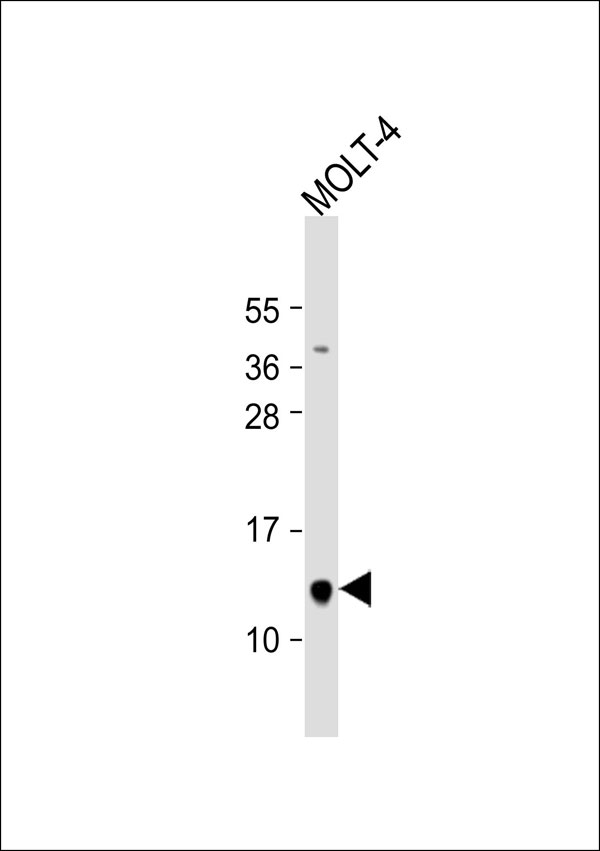PP15 Antibody
Purified Rabbit Polyclonal Antibody (Pab)
- SPECIFICATION
- CITATIONS
- PROTOCOLS
- BACKGROUND

Application
| WB |
|---|---|
| Primary Accession | P61970 |
| Reactivity | Human, Mouse |
| Host | Rabbit |
| Clonality | Polyclonal |
| Calculated MW | 14 KDa |
| Antigen Region | 62-111 aa |
| Gene ID | 10204 |
|---|---|
| Other Names | Nuclear transport factor 2, NTF-2, Placental protein 15, PP15, NUTF2, NTF2 |
| Target/Specificity | KLH-conjugated synthetic peptide encompassing a sequence within the center region of human PP15. The exact sequence is proprietary. |
| Dilution | WB~~ 1:1000 |
| Format | Rabbit IgG in phosphate buffered saline , pH 7.4, 150mM NaCl, 0.09% (W/V) sodium azide and 50% glycerol |
| Storage | Store at -20 °C.Stable for 12 months from date of receipt |
| Name | NUTF2 (HGNC:13722) |
|---|---|
| Function | Mediates the import of GDP-bound RAN from the cytoplasm into the nucleus which is essential for the function of RAN in cargo receptor-mediated nucleocytoplasmic transport. Thereby, plays indirectly a more general role in cargo receptor-mediated nucleocytoplasmic transport. Interacts with GDP-bound RAN in the cytosol, recruits it to the nuclear pore complex via its interaction with nucleoporins and promotes its nuclear import. |
| Cellular Location | Cytoplasm, cytosol. Nucleus outer membrane {ECO:0000250|UniProtKB:P61972}. Nucleus, nuclear pore complex {ECO:0000250|UniProtKB:P61972}. Nucleus inner membrane {ECO:0000250|UniProtKB:P61972}. Nucleus, nucleoplasm. Note=At steady state it is essentially nucleoplasmic, enriched in nucleoplasmic foci |

Thousands of laboratories across the world have published research that depended on the performance of antibodies from Abcepta to advance their research. Check out links to articles that cite our products in major peer-reviewed journals, organized by research category.
info@abcepta.com, and receive a free "I Love Antibodies" mug.
Provided below are standard protocols that you may find useful for product applications.
Background
Facilitates protein transport into the nucleus. Interacts with the nucleoporin p62 and with Ran. Acts at a relatively late stage of nuclear protein import, subsequent to the initial docking of nuclear import ligand at the nuclear envelope. Could be part of a multicomponent system of cytosolic factors that assemble at the pore complex during nuclear import.
References
Grundmann U.,et al.Nucleic Acids Res. 16:4721-4721(1988).
Paschal B.M.,et al.J. Cell Biol. 129:925-937(1995).
Ebert L.,et al.Submitted (JUN-2004) to the EMBL/GenBank/DDBJ databases.
Ota T.,et al.Nat. Genet. 36:40-45(2004).
Mural R.J.,et al.Submitted (JUL-2005) to the EMBL/GenBank/DDBJ databases.
If you have used an Abcepta product and would like to share how it has performed, please click on the "Submit Review" button and provide the requested information. Our staff will examine and post your review and contact you if needed.
If you have any additional inquiries please email technical services at tech@abcepta.com.













 Foundational characteristics of cancer include proliferation, angiogenesis, migration, evasion of apoptosis, and cellular immortality. Find key markers for these cellular processes and antibodies to detect them.
Foundational characteristics of cancer include proliferation, angiogenesis, migration, evasion of apoptosis, and cellular immortality. Find key markers for these cellular processes and antibodies to detect them. The SUMOplot™ Analysis Program predicts and scores sumoylation sites in your protein. SUMOylation is a post-translational modification involved in various cellular processes, such as nuclear-cytosolic transport, transcriptional regulation, apoptosis, protein stability, response to stress, and progression through the cell cycle.
The SUMOplot™ Analysis Program predicts and scores sumoylation sites in your protein. SUMOylation is a post-translational modification involved in various cellular processes, such as nuclear-cytosolic transport, transcriptional regulation, apoptosis, protein stability, response to stress, and progression through the cell cycle. The Autophagy Receptor Motif Plotter predicts and scores autophagy receptor binding sites in your protein. Identifying proteins connected to this pathway is critical to understanding the role of autophagy in physiological as well as pathological processes such as development, differentiation, neurodegenerative diseases, stress, infection, and cancer.
The Autophagy Receptor Motif Plotter predicts and scores autophagy receptor binding sites in your protein. Identifying proteins connected to this pathway is critical to understanding the role of autophagy in physiological as well as pathological processes such as development, differentiation, neurodegenerative diseases, stress, infection, and cancer.


